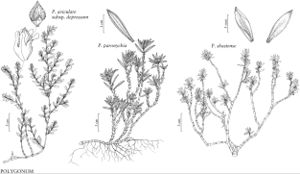Polygonum aviculare subsp. depressum
Comp. Fl. Ital., 583. 1882.
Plants green, homophyllous or subheterophyllous. Stems 3–15, prostrate to ascending, mat-forming, branched at most nodes, proximal branches divaricate, (5–) 10–50 (–100) cm. Leaves: ocrea with proximal part cylindric to funnelform, either short, 3–5.5 mm, with distal part soon disintegrating and leaving almost no fibrous remains, or long, 7–12 mm, with distal part with veins inconspicuous, membranous, margins ± lacerate, overlapping towards apices of stems and branches; petiole 0.5–3 mm; blade green, lateral-veins visible but not raised abaxially, elliptic to narrowly elliptic or oblanceolate, (6.2–) 8–27 (–35) × (1.4–) 2–7 (–10) mm, 2.8–5.7 (–6.5) times as long as wide, apex obtuse or acute, rarely longitudinally striate; stem-leaves 1–2.3 (–3.4) times as long as branch leaves. Cymes uniformly distributed or, sometimes, crowded at tips of branches, 2–7-flowered. Pedicels enclosed in ocreae, 1–2.5 mm. Flowers: perianth (1.8–) 2–3.4 (–4) mm, 1.5–2.9 times as long as wide; tube 40–57% of perianth length; tepals overlapping but spreading slightly in fruit, green or reddish-brown with white margins, oblong, flat or obscurely cucullate in fruit, outer tepals not pouched at base; midveins unbranched, thin to moderately thickened; stamens 5–7. Achenes usually slightly exserted from perianth, dark-brown, ovate, (2–) 3-gonous, 1.5–2.7 (–3) mm, faces evidently unequal, flat to concave, apex straight or slightly bent toward narrow face, almost smooth, roughened, or coarsely striate-tubercled; late-season achenes common, 2.5–4.5 mm. 2n = 40, 60.
Phenology: Flowering May–Nov.
Habitat: Fields, uncultivated areas, waste places, roadsides
Elevation: 0-2500 m
Distribution

Introduced; Alta., B.C., Man., N.B., Nfld. and Labr., N.W.T., N.S., Ont., P.E.I., Que., Sask., Ala., Alaska, Ariz., Ark., Calif., Colo., Conn., Del., Fla., Ga., Idaho, Ill., Ind., Iowa, Kans., Ky., La., Maine, Md., Mass., Mich., Minn., Mo., Mont., Nebr., Nev., N.H., N.J., N.Mex., N.Y., N.C., N.Dak., Ohio, Okla., Oreg., Pa., R.I., S.C., S.Dak., Tenn., Tex., Utah, Vt., Va., Wash., W.Va., Wis., Wyo., Europe
Discussion
Polygonum montereyense is a distinctive morphotype that may deserve infraspecific recognition. Plants referable to it have ocreae 8–13 mm, with distal parts silvery, persistent, entire or slightly lacerate, overlapping, and few-veined. Apparently, this type is restricted to California. Plants referable to P. arenastrum in the narrow sense are the most commonly encountered form of the subspecies in North America.
Subspecies depressum has been reported from Greenland and St. Pierre and Miquelon; those reports have not been confirmed.
Selected References
None.
Lower Taxa
"/2" is not declared as a valid unit of measurement for this property.
